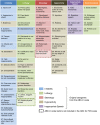The challenges of clinical trials in fragile X syndrome
- PMID: 24173622
- PMCID: PMC3932172
- DOI: 10.1007/s00213-013-3289-0
The challenges of clinical trials in fragile X syndrome
Abstract
Rationale: Advances in understanding the underlying mechanisms of conditions such as fragile X syndrome (FXS) and autism spectrum disorders have revealed heterogeneous populations. Recent trials of novel FXS therapies have highlighted several challenges including subpopulations with possibly differential therapeutic responses, the lack of specific outcome measures capturing the full range of improvements of patients with FXS, and a lack of biomarkers that can track whether a specific mechanism is responsive to a new drug and whether the response correlates with clinical improvement.
Objectives: We review the phenotypic heterogeneity of FXS and the implications for clinical research in FXS and other neurodevelopmental disorders.
Results: Residual levels of fragile X mental retardation protein (FMRP) expression explain in part the heterogeneity in the FXS phenotype; studies indicate a correlation with both cognitive and behavioral deficits. However, this does not fully explain the extent of phenotypic variance observed or the variability of drug response. Post hoc analyses of studies involving the selective mGluR5 antagonist mavoglurant and the GABAB agonist arbaclofen have uncovered significant therapeutic responses following patient stratification according to FMR1 promoter methylation patterns or baseline severity of social withdrawal, respectively. Future studies designed to quantify disease modification will need to develop new strategies to track changes effectively over time and in multiple symptom domains.
Conclusion: Appropriate selection of patients and outcome measures is central to optimizing future clinical investigations of these complex disorders.
Figures
Similar articles
-
Unstable mutations in the FMR1 gene and the phenotypes.Adv Exp Med Biol. 2012;769:78-114. doi: 10.1007/978-1-4614-5434-2_6. Adv Exp Med Biol. 2012. PMID: 23560306 Free PMC article. Review.
-
Advances in the Understanding of the Gabaergic Neurobiology of FMR1 Expanded Alleles Leading to Targeted Treatments for Fragile X Spectrum Disorder.Curr Pharm Des. 2015;21(34):4972-4979. doi: 10.2174/1381612821666150914121038. Curr Pharm Des. 2015. PMID: 26365141 Free PMC article. Review.
-
Therapeutic strategies in fragile X syndrome: dysregulated mGluR signaling and beyond.Neuropsychopharmacology. 2012 Jan;37(1):178-95. doi: 10.1038/npp.2011.137. Epub 2011 Jul 27. Neuropsychopharmacology. 2012. PMID: 21796106 Free PMC article. Review.
-
Mechanism-based treatments in neurodevelopmental disorders: fragile X syndrome.Pediatr Neurol. 2014 Apr;50(4):297-302. doi: 10.1016/j.pediatrneurol.2013.12.001. Epub 2013 Dec 4. Pediatr Neurol. 2014. PMID: 24518745 Review.
-
Epigenetic characterization of the FMR1 gene and aberrant neurodevelopment in human induced pluripotent stem cell models of fragile X syndrome.PLoS One. 2011;6(10):e26203. doi: 10.1371/journal.pone.0026203. Epub 2011 Oct 12. PLoS One. 2011. PMID: 22022567 Free PMC article.
Cited by
-
The utility of rodent models of autism spectrum disorders.Curr Opin Neurol. 2015 Apr;28(2):103-9. doi: 10.1097/WCO.0000000000000183. Curr Opin Neurol. 2015. PMID: 25734952 Free PMC article.
-
Molecular Biomarkers in Fragile X Syndrome.Brain Sci. 2019 Apr 27;9(5):96. doi: 10.3390/brainsci9050096. Brain Sci. 2019. PMID: 31035599 Free PMC article. Review.
-
Protein synthesis levels are increased in a subset of individuals with fragile X syndrome.Hum Mol Genet. 2018 Jun 15;27(12):2039-2051. doi: 10.1093/hmg/ddy099. Hum Mol Genet. 2018. PMID: 29590342 Free PMC article.
-
Are there new advances in the pharmacotherapy of autism spectrum disorders?World Psychiatry. 2017 Feb;16(1):101-102. doi: 10.1002/wps.20398. World Psychiatry. 2017. PMID: 28127936 Free PMC article. No abstract available.
-
Characterization of a mGluR5 Knockout Rat Model with Hallmarks of Fragile X Syndrome.Life (Basel). 2022 Aug 25;12(9):1308. doi: 10.3390/life12091308. Life (Basel). 2022. PMID: 36143345 Free PMC article.
References
-
- Aman MG, Singh NN, Stewart AW, Field CJ. The aberrant behavior checklist: a behavior rating scale for the assessment of treatment effects. Am J Ment Defic. 1985;89:485–491. - PubMed
-
- Ascano M, Jr, Mukherjee N, Bandaru P, Miller JB, Nusbaum JD, Corcoran DL, Langlois C, Munschauer M, Dewell S, Hafner M, Williams Z, Ohler U, Tuschl T. FMRP targets distinct mRNA sequence elements to regulate protein expression. Nature. 2012;492:382–386. doi: 10.1038/nature11737. - DOI - PMC - PubMed
Publication types
MeSH terms
LinkOut - more resources
Full Text Sources
Other Literature Sources
Medical



